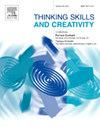Enhancing undergraduate creative thinking through a constructivist mobile learning application: Design, development, and evaluation
IF 3.7
2区 教育学
Q1 Social Sciences
引用次数: 0
Abstract
The deficiency of advanced cognitive abilities, especially creative thinking, among Thai students is a considerable difficulty within the educational system. This study aimed to design, develop, and evaluate a mobile application based on constructivist learning principles to enhance creative thinking among undergraduate students. Employing a mixed-methods approach, the research was conducted in two phases. First, the mobile application’s elements were designed based on input from 100 undergraduate students and nine experts through interviews and surveys. Second, a quasi-experimental design with 100 undergraduate students (50 experimental, 50 control) was used to assess the application’s effectiveness. The developed mobile application incorporated six core components: problem base, learning resources, scaffolding, center for collaborative learning, coach, and creative thinking center. Quantitative analysis revealed statistically significant improvements in creative thinking scores for the experimental group across all four dimensions: fluency, flexibility, originality, and elaboration (p < .001), with large effect sizes (η² ranging from 0.73 to 0.85). Qualitative data from student interviews corroborated these findings, highlighting the application’s role in fostering rapid idea generation, adaptive thinking, originality, and detailed idea development. This study contributes new insights into the effective use of mobile applications for enhancing creative thinking in higher education settings. The findings demonstrate the potential of technology-enhanced learning environments based on constructivist principles to promote critical thinking and knowledge construction. Future research should explore long-term impacts, cross-cultural applicability, and potential adaptations for diverse educational contexts.
通过建构主义移动学习应用程序增强大学生创造性思维:设计、开发和评估
泰国学生缺乏先进的认知能力,特别是创造性思维,这在教育系统中是一个相当大的困难。本研究旨在设计、开发并评估一款基于建构主义学习原则的手机应用,以提升大学生的创造性思维。采用混合方法,研究分两个阶段进行。首先,移动应用程序的元素是基于100名本科生和9名专家通过访谈和调查的输入而设计的。其次,采用准实验设计对100名本科生(50名实验学生,50名对照学生)应用程序的有效性进行评估。开发的移动应用包含六个核心组件:问题库、学习资源、脚手架、协作学习中心、教练和创造性思维中心。定量分析显示,实验组的创造性思维得分在所有四个维度上都有统计学上的显著提高:流畅性、灵活性、独创性和精细化。.001),效应量大(η²范围为0.73 ~ 0.85)。来自学生访谈的定性数据证实了这些发现,强调了应用程序在培养快速创意产生、适应性思维、独创性和详细创意发展方面的作用。这项研究为在高等教育环境中有效使用移动应用程序来增强创造性思维提供了新的见解。研究结果表明,基于建构主义原则的技术增强学习环境具有促进批判性思维和知识建构的潜力。未来的研究应探讨长期影响、跨文化适用性和潜在的适应不同的教育背景。
本文章由计算机程序翻译,如有差异,请以英文原文为准。
求助全文
约1分钟内获得全文
求助全文
来源期刊

Thinking Skills and Creativity
EDUCATION & EDUCATIONAL RESEARCH-
CiteScore
6.40
自引率
16.20%
发文量
172
审稿时长
76 days
期刊介绍:
Thinking Skills and Creativity is a new journal providing a peer-reviewed forum for communication and debate for the community of researchers interested in teaching for thinking and creativity. Papers may represent a variety of theoretical perspectives and methodological approaches and may relate to any age level in a diversity of settings: formal and informal, education and work-based.
 求助内容:
求助内容: 应助结果提醒方式:
应助结果提醒方式:


